A material that could help keep your heart going – lead zirconium titanate
What does it look like?

Grey spheres represent lead atoms and the red spheres oxygen atoms. The atom in the middle is titanium 90% of the time, and zirconium the other 10%. Image generated by the VESTA (Visualisation for Electronic and STructural analysis) software http://jp-minerals.org/vesta/en/
What is it?
We introduced a piezoelectric material, Quartz, back in January. This is a phenomenon where creating a small pressure on a crystal structure created a spark of electricity, as discovered by Pierre Curie, along with his brother Jacques. Piezoelectric materials have proved useful in a wide range of materials, not least in pacemakers.
The most commonly used piezoelectric material is known as lead zirconium titanate, or PZT (the P standing for Pb, the elemental symbol of lead). PZT is actually a material made from a mixture of lead zirconate, and lead titanate – a solid solution like Alite. The structure is based on our old friend the perovskite structure, with the lead and oxygen atoms providing the backbone of the crystal arrangement. The titanium and zirconium atoms are then disordered, and cause the tetragonal symmetry of the structure. It's the interactions of these as the pressure is applied that creates the electricity.
Where did the structure come from?
As it's a solid solution, there are a multitude of crystal structures of PZT. In the structure that we have featured, 1 in every 10 of the titanium atoms is substituted with a Zirconium atom; it is #1513334 in the Crystallography Open Database.






